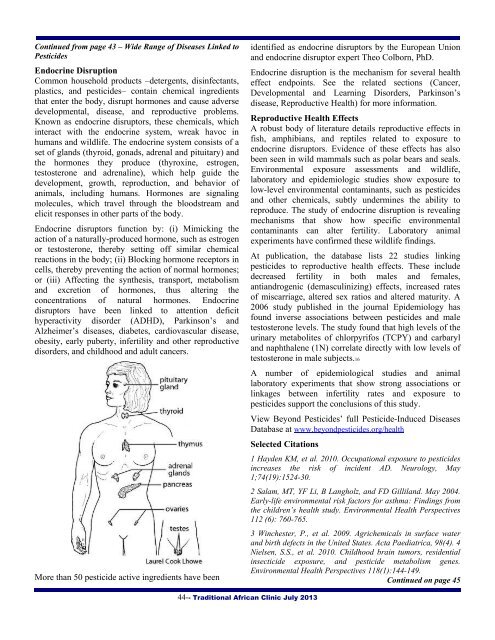toxicity - pesticides, herbicides and insecticides - Blackherbals.com
toxicity - pesticides, herbicides and insecticides - Blackherbals.com
toxicity - pesticides, herbicides and insecticides - Blackherbals.com
Create successful ePaper yourself
Turn your PDF publications into a flip-book with our unique Google optimized e-Paper software.
Continued from page 43 – Wide Range of Diseases Linked toPesticidesEndocrine DisruptionCommon household products –detergents, disinfectants,plastics, <strong>and</strong> <strong>pesticides</strong>– contain chemical ingredientsthat enter the body, disrupt hormones <strong>and</strong> cause adversedevelopmental, disease, <strong>and</strong> reproductive problems.Known as endocrine disruptors, these chemicals, whichinteract with the endocrine system, wreak havoc inhumans <strong>and</strong> wildlife. The endocrine system consists of aset of gl<strong>and</strong>s (thyroid, gonads, adrenal <strong>and</strong> pituitary) <strong>and</strong>the hormones they produce (thyroxine, estrogen,testosterone <strong>and</strong> adrenaline), which help guide thedevelopment, growth, reproduction, <strong>and</strong> behavior ofanimals, including humans. Hormones are signalingmolecules, which travel through the bloodstream <strong>and</strong>elicit responses in other parts of the body.Endocrine disruptors function by: (i) Mimicking theaction of a naturally-produced hormone, such as estrogenor testosterone, thereby setting off similar chemicalreactions in the body; (ii) Blocking hormone receptors incells, thereby preventing the action of normal hormones;or (iii) Affecting the synthesis, transport, metabolism<strong>and</strong> excretion of hormones, thus altering theconcentrations of natural hormones. Endocrinedisruptors have been linked to attention deficithyperactivity disorder (ADHD), Parkinson’s <strong>and</strong>Alzheimer’s diseases, diabetes, cardiovascular disease,obesity, early puberty, infertility <strong>and</strong> other reproductivedisorders, <strong>and</strong> childhood <strong>and</strong> adult cancers.More than 50 pesticide active ingredients have beenidentified as endocrine disruptors by the European Union<strong>and</strong> endocrine disruptor expert Theo Colborn, PhD.Endocrine disruption is the mechanism for several healtheffect endpoints. See the related sections (Cancer,Developmental <strong>and</strong> Learning Disorders, Parkinson’sdisease, Reproductive Health) for more information.Reproductive Health EffectsA robust body of literature details reproductive effects infish, amphibians, <strong>and</strong> reptiles related to exposure toendocrine disruptors. Evidence of these effects has alsobeen seen in wild mammals such as polar bears <strong>and</strong> seals.Environmental exposure assessments <strong>and</strong> wildlife,laboratory <strong>and</strong> epidemiologic studies show exposure tolow-level environmental contaminants, such as <strong>pesticides</strong><strong>and</strong> other chemicals, subtly undermines the ability toreproduce. The study of endocrine disruption is revealingmechanisms that show how specific environmentalcontaminants can alter fertility. Laboratory animalexperiments have confirmed these wildlife findings.At publication, the database lists 22 studies linking<strong>pesticides</strong> to reproductive health effects. These includedecreased fertility in both males <strong>and</strong> females,anti<strong>and</strong>rogenic (demasculinizing) effects, increased ratesof miscarriage, altered sex ratios <strong>and</strong> altered maturity. A2006 study published in the journal Epidemiology hasfound inverse associations between <strong>pesticides</strong> <strong>and</strong> maletestosterone levels. The study found that high levels of theurinary metabolites of chlorpyrifos (TCPY) <strong>and</strong> carbaryl<strong>and</strong> naphthalene (1N) correlate directly with low levels oftestosterone in male subjects.16A number of epidemiological studies <strong>and</strong> animallaboratory experiments that show strong associations orlinkages between infertility rates <strong>and</strong> exposure to<strong>pesticides</strong> support the conclusions of this study.View Beyond Pesticides’ full Pesticide-Induced DiseasesDatabase at www.beyond<strong>pesticides</strong>.org/healthSelected Citations1 Hayden KM, et al. 2010. Occupational exposure to <strong>pesticides</strong>increases the risk of incident AD. Neurology, May1;74(19):1524-30.2 Salam, MT, YF Li, B Langholz, <strong>and</strong> FD Gillil<strong>and</strong>. May 2004.Early-life environmental risk factors for asthma: Findings fromthe children’s health study. Environmental Health Perspectives112 (6): 760-765.3 Winchester, P., et al. 2009. Agrichemicals in surface water<strong>and</strong> birth defects in the United States. Acta Paediatrica, 98(4). 4Nielsen, S.S., et al. 2010. Childhood brain tumors, residentialinsecticide exposure, <strong>and</strong> pesticide metabolism genes.Environmental Health Perspectives 118(1):144-149.Continued on page 4544-- Traditional African Clinic July 2013
















